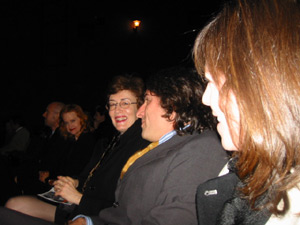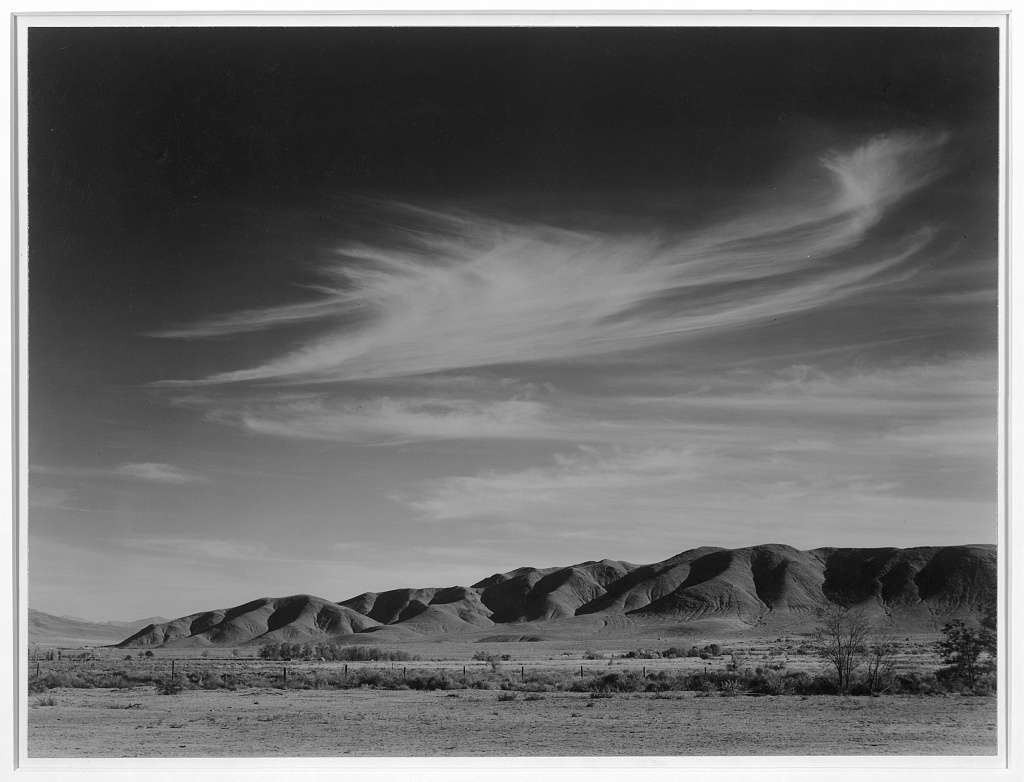For almost three years, I’ve carried a little red movie ticket in my wallet, the old-fashioned pulpy kind, from a big roll. It says “Emergency Re-admit” on it. It enables me to return and see Dancer in the Dark, which I went to see one weekday afternoon in 2000. After 15 confusing minutes, I snapped and decided I’d better get back to work, and I hastily, if temporarily, abandoned the controversial film.

Last night, I watched it on DVD, and it blew me away. It’s not just a movie starring a singer, it’s a musical. All this time, I’d assumed that meant it had some aggressively amateurish Sound of Music renditions, with Catherine Deneuve and Bjork as added gimmicks. So I was half-watching while writing when the first actual musical number came on, almost halfway into the film. After that, I was transfixed.
Von Trier was intent on “covering” the musical numbers in one take, as live events–come what may audio-, image-, and mistake-wise– using 100 cameras. It didn’t quite happen that way. They did use 100 fixed, synch-coded DV cameras (140 for one song), covering the entire performance area, and they shot several takes, all the way through. Additional crews shot close-ups of Bjork. The result: a staggering amount of footage (68 hours for one three minute song) and, presumably, a big job in post.
Rapid cuts between fixed shots stands in sharp contrast to the never-resting hand-held camerawork in the rest of the film. From the commentary tracks, the choreographer Vince Paterson, who did the Vogue video, meted out whip-cracking tough love, Madonna-style, on his Dogme-soaked, improv-happy collaborators. Vince made sure the 100 cameras positions and framing was actually based on the staging. His impressive combination of imperiousness and restraint comes through in his commentary, (“We found out it would serve our purpose much better to involve me.”) and it’s not hard to accept von Trier’s comment that Paterson saved the movie.
The limitations of this ultimately low-tech, handcrafted sophistication are apparent, though. Von Trier rightly laments the short cuts it produces: “Maybe if you had 2,000 cameras, you could get some longer cuts and closeups.” At the same time, he argues strongly against editing between multiple takes and for multi-camera coverage of a single performance. It all reminds me of The Matrix Reloaded, of all things. Specifically, the god-like CG camera technique the Wachowksis and Maeda used to film The Burly Man fight, the one with 100 Agent Smiths and thousands of cameras.
Category: making movies
Everyone’s Making Movies
Well, Jason is, anyway. It’s a love story. Believe me, you’ll laugh, you’ll cry.
ISO: Warner’s Little Brother (or Sister?)
In the the Observer’s “Satisfying Mr. Soderbergh”, Rebecca Traitser writes about Warner Brothers’ drawn out search for someone to head up their long-planned specialty film division. One of the key requirements of the job: make Steven Soderbergh happy by releasing his films properly.
One name that being bandied about was Elvis Mitchell, the aim-for-the-blurbing-bleachers NYTimes critic. But whoever the new studio head is, Traitser lays out a combination of director-sympathy and strategy-awareness that makes me think she’s gunning to succeed him.
Badass Buddy Icons and the Honda Element
Thanks to a 13-year old niece of Boing Boing, I found Badass Buddy. It’s a site with 1,200 AIM free buddy icons, a collection which, over 2+ years, has evolved from simple riffs on the little AOL dude (you know, the one who hooked up with Sharon Stone) into a unique medium of its own.



In addition to the predictable ones–Fart, Spongebob, Jackass, School Sucks– BAB has created little narratives that are HI-larious, timely, touching, and pretty damn cool. To tell these tiny stories, BAB sometimes treats the icon window as a screen, or as a camera. And they adapted some recognizably cinematic visual language, including “camera” angles and movement (e.g., pans, zooms), lighting effects, editing (shot/reverse-shot, establishing/close-up, jump cuts), even Bullet Time.





But they also play off the unique characteristics of the medium–a medium which was probably never intended as one, but which has been embraced and exploited to express the worldview of an IM generation.




But as soon as I try to decide which buddy icon I’m gonna use, an alarm sounds in my head, which brings me to the Honda Element. It’s ugly, I know, but I like it, and I kinda want one. The wife’s worried it might be Pontiac Aztek-ugly (i.e., lame and embarassing) but my gut tells me it’s Citroen 2CV-ugly (i.e., cool and if you just don’t get it, you’re lame). I’m almost always right about that kinda stuff, though; that’s not the problem.
The problem is something new to me, age-appropriateness. According to Honda, the Element was designed as a “dorm room on wheels.” According to the auto industry’s demographic master strategy, I shouldn’t want a “dorm room on wheels” any more than I want a “living room on wheels.” But even if there were a “loft on wheels,” my indignation at being so target marketed would probably keep me from buying it. (It’s a Gen-X thing, you wouldn’t understand. Unless you read Newsweek.)

But if I buy an Element, I worry about two equally bad scenarios: 1) it’s only marketed as designed for the under-30 demo, which means it appeals only to people over 35, who try too hard. I buy one and subsequently telegraph my aging wannabe-ness. Call this the Miata Scenario, and if you’re old enough to remember the launch of the Miata, give up. It’s already too late for you. 2) it’s actually designed for the under-30 demo, and they embrace it. I buy one and become as lame as when your dad starts saying he’s “down with that, yo” to you. Call this one the Badass Buddy Scenario.
On Getting Gawker Stalked

Wave UFO, Mariko Mori for the Public Art Fund
image: Tom Powel, nytimes.com
INT – DAY, IBM BAMBOO GARDEN, 56th & MADISON
A promising DIRECTOR wanders into the atrium to examine Mariko Mori’s Wave UFO, a large, shiny pod-looking art object nestled among the towering thickets of bamboo. A YOUNG ARTIST mills about, hesitant to approach him.
Um, Excuse me.
DIRECTOR
Huh?
YOUNG ARTIST
Did you have a film in the MoMA Documentary Festival?
DIRECTOR
(shocked, confused, with a hesitant inflection)
Umm….yes.
YOUNG ARTIST
I saw it. You spoke after, too. It was really nice.
DIRECTOR
Thanks. (stammer) Thank you.
The two chat briefly, then the ARTIST leaves. Suddenly, from out of a clump of bamboo, CELEBRITY, THE CRUEL MISTRESS appears, looking a lot like the Black Queen in X-Men5: The Hellfire Club. She has been observing the scene, unnoticed. She approaches the DIRECTOR and places her black-gloved hand on his tensed-up shoulder. Startled, the DIRECTOR turns around.
So, the tables have turned.
DIRECTOR
Huh?
CELEBRITY, THE CRUEL MISTRESS
The gawker is now the gawked.
But remember, only the first one is free.
CELEBRITY, THE CRUEL MISTRESS disappears behind the shiny pod, and the DIRECTOR looks around, appearing nonplussed, but secretly high, and already (zeta-)jonesing for another hit.
Boxing Isabella: Guy Maddin’s Production Diary

Also from the Voice: I have no idea what to make of Guy Maddin’s production diary for his newest film, The Saddest Music in the World, but it’s good readin’. Something to do with a legless Isabella Rossellini. Don’t let the film’s absence from Maddin’s IMDb entry get to you, either. (I mean, if Charlie Kaufman’s brother can get nominated for an Oscar…)
Maddin’s got a joint at the Tribeca Film Festival and a Dracula: The Ballet movie opening at FilmForum next week. Really.
On What are you working on?
I don’t mean in the sense of “So, what do you do?” for people whose profession (e.g., writers, filmmakers…especially writers) might not appear to involve actually doing very much.
I mean in the nosy sense. A boss or busybody or fisher of insider information might ask you what you’re working on, leaving you to wonder what, exactly, they’re getting at. To avoid the appearance of micromanaging, hovering, or intrusion, the passive aggressive boss might install cameras (“They’re just webcams!” he might say chirpily.) and offer assurances that they’ll only be accessible “to Charles and James and myself,” and all they’re for is to “read the whiteboard in the lab” or to “see if you’re there before coming over” (telephones being an outmoded way of contacting you, apparently).
Then, when the “webcam” is installed, and it turns out to be housed in a little smoked glass dome, and to pan and zoom, via remote control, then your boss really will know what you’re working on, because now, he can follow you around the lab with his camera. At meetings, the webcamming managers will giggle at their new toy, which in the very techy, science-y, even, culture of your workplace, is now an object of gadget envy, by people who don’t work within its lens’s reach, of course.

Monitor, 1998, Craig Kalpakjian
Andrea Rosen Gallery, image:momentaart.org
In the first week, you’ll know your boss knows what you’re working on, because it’ll turn out the “webcam” can read a monitor on an experiment–oh, and your computer screen–from across the room. It can zoom in on your colleague’s nascent ear hair, “Did you know Craig has ear hair?” becoming a topic of conversation among the admins in your bosses’ offices. IT people you’ve never met will smile at you in the hall, and say hi like an old friend. Occasionally, a stranger’ll just drop by to chat; she’d always meant to introduce herself before–you seemed so interesting. Her eyes dart furtively to the black dome and back as you talk, and you say to yourself, if she were a cop, she’d blow the sting.
Your neck and shoulders will seize up by the end of the week, and only when you point out to your male colleague that they’re checking out his ass, too, you know, will his disgust for the ideological implications of these controlling cameras overcome his entrenched gadgetophilia. When you impose on the head of the project for a few minutes of his time that afternoon, he will explain the extremely circumscribed authorized uses–and users–of the camera and he’ll reassure you that any fears you will have are unfounded. Then he’ll ask, in confidence, why, have you heard something different? Then you’ll unfold the totality of the harsh spotlight you are under, the misuse and intrusion that inexorably attends the installation of surveillance cameras, and that will missioncreep back, as long as the cameras are there.
Late on that Friday afternoon, a stern mass email will go out–he’s a pretty no-nonsense guy, all said and done–from the project head, “the cameras will be disabled immediately, pending the development of an appropriate use policy.” An IT guy you’ve never seen will say hi to you as if you’d shared an office once when he comes to hastily remove the cable. When you come in on Monday, you’ll be surprised to see the cameras gone, even their bolt holes puttied and painted over. You’ll login to your email to find another mass email from the project head, announcing the cameras’ demise, timestamped Saturday evening.
This surveillance camera drama is brought to you courtesy of my wife and her colleagues at NASA. See performances with far unhappier endings, by the Surveillance Camera Players, at “Psy-Geo-Conflux” this weekend, a culture happening you’ll still not quite grasp after reading this Village Voice article. I do get that the cool Wooster Collective folks‘ll be doing a walking tour of street art, though.
On First Films
John Malkovich has been doing the media circuit for The Dancer Upstairs, his directorial debut, and it sounds pretty respectable.
It got me thinking, so I made some Amazon lists for your blogger-/info-/shopper-tainment:
Bonus links [thanks, Fimoculous]: 25th Hour author David Benioff writes in the Guardian about adapting his nearly unpublished novel, first for Tobey Maquire, then for Spike Lee. He sounds a lot tougher than he did in W Magazine. Maybe it’s because he’s sharing writing credit with, um, Homer on his next movie.
Or because he’s published alongside Thomas freakin’ Pynchon, who takes a thoughtful, ultimately optimistic look at Orwell’s 1984.
On The Real The Real Cancun

“Who wants to star in The Real Cancun 2?” image: therealcancun.com
As a maker of documentary-looking films, I was a reluctant fan of New Line’s The Real Cancun once I figured out what it was. Now that I’ve read Joel Stein’s hi-larious review in New Line’s corporate sibling pub, Time, I’m now a fan of entertainment synergy, too. The real Real Cancun sounds even better than the film itself:
…[the film’s 16 thrown-together non-actors] indirectly deliver the requisite moral lesson of a teen comedy: casual sex, even for loutish frat boys, is a pain. “In our house, the girls got all hurt if we brought another girl home,” says Matt, 20, an Arizona State student. “They acted like we were a big family, but we’d only known each other for a few days.”
…
“There were things that the producers told me I couldn’t do,” says Casey, 25, a Miami model. “There was one point where I hooked up with Trishelle from The Real World Las Vegas [who was there for MTV], and the producer said I wasn’t allowed to hang out with her because she’s under contract for other things.”
And unlike documentarians, the producers, who have to work with MTV in their day jobs, felt it prudent to edit out the more controversial scenes, such as the one in which the twins have an angry, cursing fight with rapper Snoop Dogg in his post-concert trailer after, they say, he tried to get amorous with them…says twin Nicole, “Celebs like him are just average normal people. But he’s more of a slut than the average person”
…
“I’d rather be known for this instead of being smart or something,” says [other twin, Roxanne]. “There’s a million people who are smart. There’s only 16 of us who were in Cancun together.”
Maybe this year, Roxanne. [Even Lawrence Van Der Gelder’s entirely point-missing NYT review is entertaining.]
A Report From An Overcast Magic Hour In NYC
Last evening, 7:30, heading to a tour a friend gave a museum group of her art collection, I was momentarily freaked out by the light.
At first, I figured it’s how streetlights turn on before it gets dark, but no. The sky was mottled, completely overcast, a bright, diffused, grey>>faint plum lightbox. It was that post-sundown interlude cinematographers call magic hour, except you never hear about “cloudy magic hour.” For some reason, the light was cold, and every streetscape detail had a hardcut crispness.
Then, I turned into my Korean deli, of the narrow middle-of-the-block variety, and was freaked out again. Was it the contrast with the strange outside light? Something wasn’t right. So I asked, and, sure enough, they’d packed the ceiling with new fixtures, all filled with full-spectrum fluorescent tubes. $20 each, the owner proudly boasted. It was like shopping in a Gursky photo. I walked back out–with enhanced calcium absorption powers, apparently–into the separate-but-equally intense twilight.
[Read an ASC‘s interview with Thin Red Line DP John Toll. “Because this is a Terrence Malick film, a lot people will just assume that we sat around waiting for magic hour, but we simply didn’t have the luxury of doing that… We had a 180-page script…Yes, there are magic-hour shots in the film, but only because we had to shoot until it got dark!]
On Relieving Payne, On Power And Behind-The-Scenes

from r: Jane, David, Nancy, Swoosie
First, the good. Star photographer-to-the-stars Patrick McMullan has posted Billy Farrell’s party pics from the Alexander Payne event last week.
Then, the lame. In a bit they call House of Payne, the Daily News pretends that Alexander Payne was a pain in the ass and that “he should get over himself,” slamming him for his “snippiness” toward good friend and interviewer, UA chief (and legendary indie film producer/distributor) Bingham Ray. But it’s totally not true. Here’s the deal: Rush & Molloy are too afraid of upsetting a studio head by saying he talked too much or sometimes inadvertently cut Alexander off; instead, they’ll take lame shots at an extremely friendly, self-conscious director.
Ray and Payne had gone off earlier in the day to discuss what themes and ideas they’d talk about on stage. During the rehearsal, their back-and-forth conversation was both animated and fascinating. Both are behind-the-camera guys; performing for a crowd doesn’t come naturally to either of them. When the lights went down, Alexander was much more self-conscious, and Bingham was much more talkative.
Many people told me they found the whole conversation very interesting. Some found it interesting, but thought Ray talked too much, at least for an event about Payne. And a couple of people wondered, who was that guy? If that’s you, you’re not in the film industry. But if you know Bingham Ray, you want to work with him, and so you’re probably not going to tell him he talked too much. It’s the paradox of power.
My take: Ray said several times that night he’d never spoken in a one-on-one format like that, and he’d be mortified to think he messed up Payne’s evening in some way. So if he talked over Alexander’s answer, or told some story of his own, it was with the best of intentions. But hold a position of power and be sought out for your vision, for a long time, and you can become accustomed to being listened to. Bill Clinton was the same way. And Payne was a combination of polite, nervous and self-effacing; he’s not gonna call a friend on something in front of a crowd, and his own reluctance to analyze his work beat out any fleeting desire to spoon-feed the crowd.
As these two brilliant behind-the-camera guys gamely put on their best show, the producer sitting next to me had quickly figured it out. She leaned over to me at one point and whispered, “I want to hear the DVD commentary track for this.”
If Ric Burns Calls, Tell Him You’re Busy.
Today’s Guardian asks twelve actual historians to lend their authoritative-sounding accents on politicians’ arguments that Iraq is the next [check all that apply]
1939 Germany
1956 Egypt
1967 Israel
1991 Iraq
1963 Vietnam
1899 South Africa
1936 Ethiopia
A long time ago in a galaxy far, far away Naboo
As someone who made a movie (S(N01)) about looking at the past (WWI) to make sense of the present (Sept. 11), I’m interested. One big lesson is best expressed by Simon Schama: “I’m allergic to lazy historical analogies. History never repeats itself, ever. That’s its murderous charm.”
Another: historians are almost as likely as politicians to slip from historical analogy to histrionic advocacy. For example Andrew Roberts‘ unsubtle derision: “The League of Nations, on the morning after Poland was invaded, had on its urgent agenda the standardisation of European railway gauges. Today’s United Nations is fast shaping up to be equally ineffectual.” (See if you can read between ‘ lines.)
And even though it would catapult S(N01) up the relevance scale, I hope Norman Davies is wrong comparing Iraq to 1914 Russia:
So what about 1914? The strongest military power in sight (Germany) is made to feel insecure by a terrorist outrage. Instead of confining its response to the known source of the terrorism (Serbia), it lashed out at one country, which it suspected of abetting the terrorists (Russia), and then at another country (France), which was linked to the first. Then it lost the plot. Worst of all, it calculated that the war would be won by Christmas.
I Mean, Just Look How Happy They Were!

In 1990, just out of school, I was transfixed by a copy of Ansel Adam’s self-published book, Born Free And Equal, at a big antiques show. At $200, it was the most expensive book I’d ever wanted, and I choked. Almost five years of searching later, it was the first thing I bought online, from a collector on a photography newsgroup. [Of course, now you can almost always find a copy on Abebooks.] Adams’ combined his photographs–signature landscapes, portraits and documentary shots–of the Japanese American internment camp in Manzanar, CA with his scathing text to condemn the US government’s (all three branches) stripping of US citizens’ and residents’ civil rights.
Published in 1944, Adams’ book was poorly received, no surprise. Many copies were reportedly burned, and today, it is an exceedingly rare, little known work by a very famous photographer. Since the 1960’s, the Manzanar collection has been at the Library of Congress. Tell Jack Valenti when you want to see his neck twitch: Adams put these pictures into the public domain, to assure their survival. View all 244 images here.

Why do I post this now? Well, I have contemplated ideas for a film based in the camps. And a John Ashcroft deputy has suggested such camps for Arab Americans would not be illegal. But now, a Congressman from North Carolina (home state, thanks), the Chairman of the House Subcommittee on Domestic Security, has defended the camps, proclaiming them “appropriate” and “for their [the Japanese’] own safety.” Two branches down, one to go.
[2024 update: I actually used to hotlink images, that is how idealistic I was about the permanent informational utopia we were building on the world wide web and the direction copyright and fair use was heading in 2003. lol]
Washington, DC Is The Kind Of Movie Town Where
Can’t Wait To See It

Anthony Lane on Keith Fulton and Louis Pepe’s documentary, Lost in La Mancha: “For anyone who suffers from the wish to make movies, or who fears that this terrible condition may strike at any time, here is the cure.”
